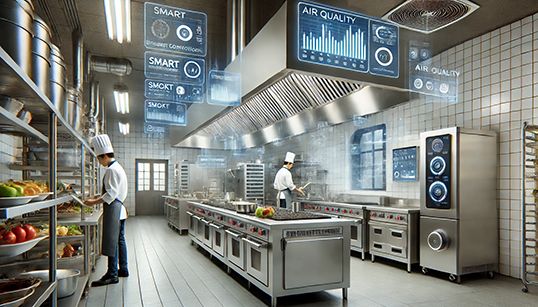In the race for smarter homes, the kitchen has become a hotbed of tech upgrades—from voice-controlled ovens to refrigerators that text you when you're low on milk. But one piece of the puzzle remains stuck in the past: kitchen ventilation.
It's time we talk about it.
The Invisible Problem
Most people don’t think about their range hood until it becomes an issue—until the smoke lingers, the grease coats everything, or the burnt salmon smell clings for days. Yet poor ventilation isn’t just an annoyance. It's a health and safety risk.
Cooking releases heat, moisture, carbon monoxide, formaldehyde, and ultrafine particles into the air. Without effective ventilation, those pollutants don't go away. They recirculate. They settle. They end up in your lungs.
And most standard range hoods? They're underpowered, loud, inefficient, and designed more for aesthetics than function.
What’s Wrong with What We Have?
The core technology behind kitchen hoods hasn’t changed much in decades. It's still mostly fans and filters, often installed as an afterthought. Common problems include:
-
Noise over performance – Louder doesn’t mean better. Many hoods just sound powerful.
-
Inefficient airflow – Weak suction or poor capture areas let smoke and grease escape.
-
Poor integration – They rarely work in sync with other smart home systems or appliances.
-
Design compromises – Open kitchens prioritize aesthetics, often at the cost of proper ventilation.
In short, we’re cooking in environments designed to trap pollution.
Why Innovation Matters
As we move toward healthier, more sustainable homes, the kitchen can't be left behind. Innovative ventilation isn't just a luxury—it’s a necessity.
Here's where innovation can make a real impact:
-
Sensor-driven systems: Smart hoods that automatically adjust airflow based on real-time air quality.
-
Low-noise, high-efficiency motors: Quiet enough to talk over, strong enough to clear the air fast.
-
Whole-home integration: Ventilation systems that work in sync with HVAC, climate control, and smart cooking appliances.
-
Advanced filtration: Tech that captures ultrafine particles, not just grease and steam.
-
Better design thinking: Sleek, invisible systems that don’t compromise air quality for style.
The Opportunity Ahead
Innovation in kitchen ventilation isn’t just about gadgets. It's about building healthier homes and reducing indoor air pollution—a real concern in both urban apartments and suburban homes.
There’s a gap in the market, and it’s wide open.
Appliance makers, HVAC companies, architects, and designers have a chance to redefine what the modern kitchen looks like—and how it breathes. It’s time to go beyond pretty stainless steel boxes and start thinking holistically: how do we actually live in these spaces?
Final Thought
Ventilation is infrastructure. It should evolve like everything else in the home. The future of cooking isn’t just about induction cooktops or AI recipe suggestions—it’s about making the air we breathe as clean as the food we eat.
And that starts with innovation where it’s long overdue.
Breathe better. Cook smarter. It’s time.

